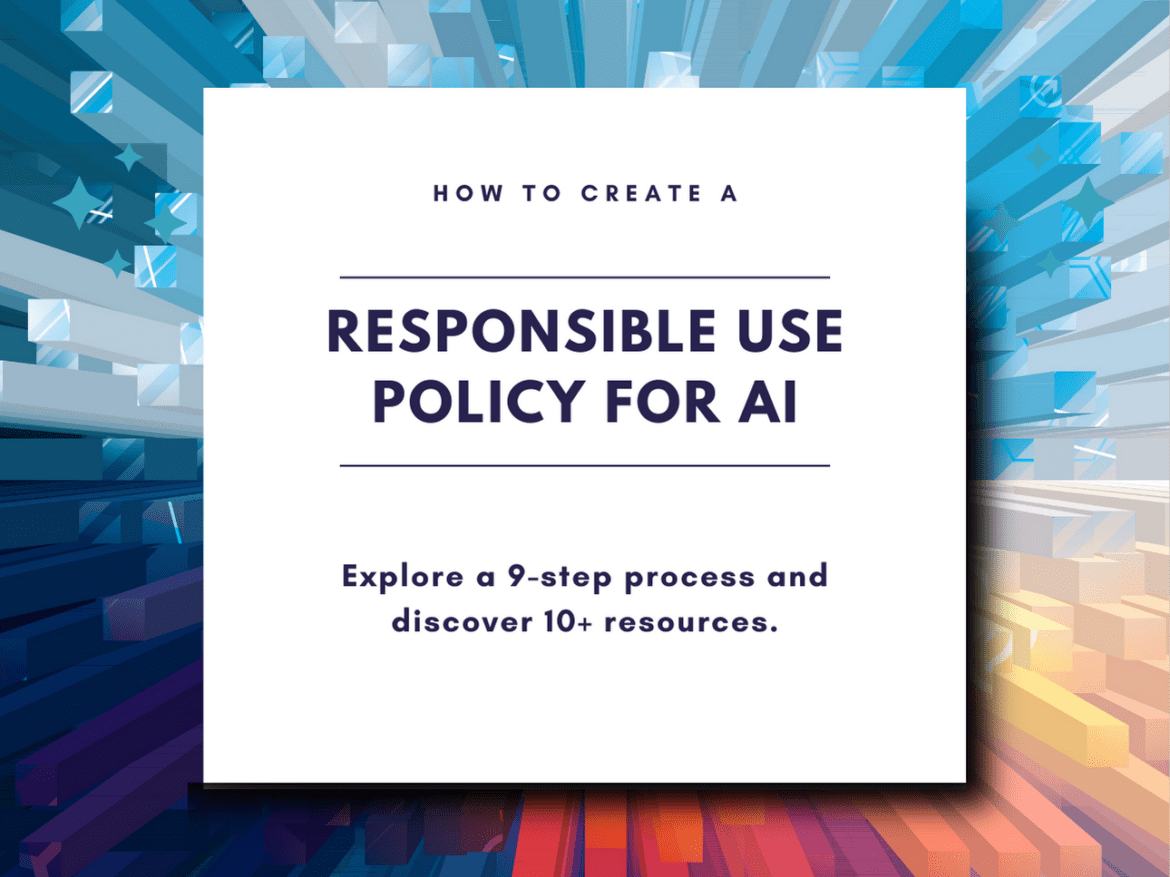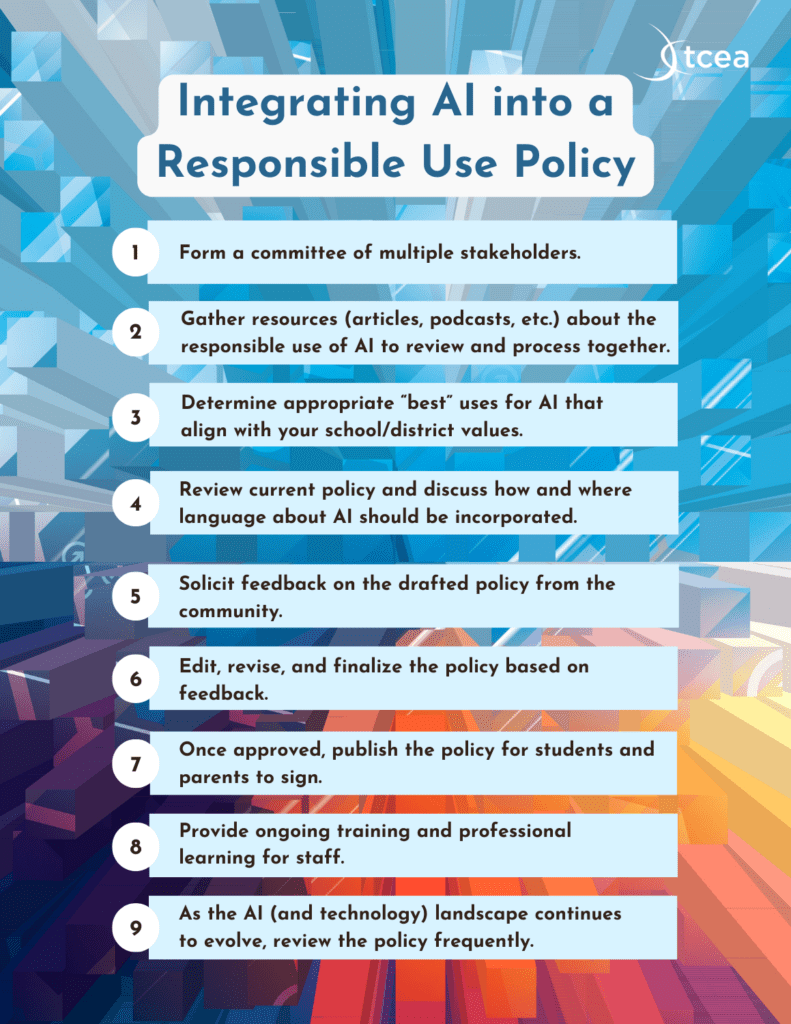It’s become more and more apparent that artificial intelligence (AI) is now a part of our everyday lives. Whether used for personal or professional reasons, AI serves many purposes and can help with or complete a variety of tasks – for educators and students. But there are benefits and risks involved, especially when it comes to data privacy and ethical use. Many schools and districts are considering or developing AI policy. Some have blocked AI altogether for both teachers and students.
But just as it was important when we moved to 1:1 devices in school settings, like it or not, it’s more important than ever before for schools to guide students and staff in learning to use AI responsibly and ethically rather than just blocking it. Let’s take a look at how we can build a foundation for acceptable, responsible use in schools through responsible use policies and help our students build good digital habits and become even more responsible digital citizens.
What Is a Responsible Use Policy (RUP)?
An RUP, also known as RUA (Responsible Use Agreement), is a formalized agreement that focuses on good digital citizenship habits and responsible use of technology. In contrast to an AUP (acceptable use policy), which outlines “dos” and “don’ts” and provides “sanctions” for misuse, an RUP intentionally focuses more on “dos.” Instead of the spotlight shining on what’s acceptable, it’s about students being responsible. Of course, it is still important for students to know who to contact about unsafe or inappropriate content or use. It is also important for them to know what will happen should they do something that doesn’t align with the RUP.
TCEA’s Miguel Guhlin points out that any misuse of technology (not just misuse of AI) should be addressed as it arises in alignment with a school’s holistic discipline policy. The same goes with academic integrity. Guhlin suggests taking a Restorative Justice approach should misuse arise. “School districts need to have aspirational documents. Misuse of AI should not be handled as a separate instance of discipline or given its own punishments.” I have to say, I completely agree.
All this is great. But how should a school approach AI when it comes to technology policy?
How to Integrate AI into an RUP
As you begin, it is important to reference your state association of school board’s policies, which have already been reviewed by a legal team, and any policy-related resources.
1. Form a committee of multiple stakeholders.
Intentionally form a committee with teachers, students, parents, administrators, technology staff, and members of the larger community represented. Ensure that there is more than one member who has experience with and knowledge of AI.
2. Gather resources (articles, podcasts, etc.) about the responsible use of AI to review and process together.
Review resources to expand the committee members’ understanding and views of how AI can be used by students to deepen learning. Explore responsible, safe, and ethical uses of AI in schools.
3. Determine appropriate “best” uses for AI that align with your school/district values.
After the committee has reviewed resources, discuss, clarify, and determine ethical, safe, and responsible ways students can use AI for learning purposes and their academic growth in your school setting.
4. Review current policy and discuss how and where language about AI should be incorporated.
Where do the committee’s determinations about AI use fit into current policy? How should the current policy be adjusted to reflect expectations for AI use moving forward? Revise and update the policy to outline and reflect expectations for the responsible and safe use of AI.
5. Solicit feedback on the drafted policy from the community.
Once the policy has been revised and updated, present the policy to the community and any governing bodies for feedback. It is important to actively listen to and hear concerns, feedback, and additional perspectives.
6. Edit, revise, and finalize the policy based on feedback.
Construct a final draft to submit for approval. Be prepared to provide background information, resources, research, and reasoning. In other words, be prepared for success or for additional changes to be made to the policy.
7. Once approved, publish the policy for students and parents to sign.
Once the policy has been approved and adopted, formalize it and provide it to staff, parents, and students, requiring students and parents to sign the policy.
8. Provide ongoing training and professional learning for staff.
In order for students to be taught to use AI safely, ethically, and responsibly, teachers must receive proper training and professional learning in this area. Educators should also receive content-specific training so they can employ safe AI tools and best practices when integrating AI into lessons, projects, and assignments.
9. As the AI (and technology) landscape continues to evolve, review the policy frequently.
A policy is a living document that should be revisited regularly and updated when necessary to reflect up-to-date research, tools, uses, and best practices. Be prepared for the use of AI to be an ongoing and ever-changing conversation within the school community, meaning your policy will likely need adjusting.
Resources for Creating an RUP
AI4K12.org: This is an initiative working to develop national guidelines for AI in K-12, a resource directory for AI instruction, and a community focused on AI in K-12 settings. There are many resources provided, such as posters, graphics, big ideas, activity guides, books, reports, and more. This site is worth spending some time on!
Classroom Policies for AI Generative Tools: This is such an interesting resource! Lance Eaton has created a crowdsourced document where educators can submit their course guidelines and policies on AI to be added to a 37+ page list. Most of the submissions are from high education sources, but this insight can certainly help us prepare our secondary students for what’s to come and give us some ideas for K-12 settings.
TeachAI.org: This brand new organization (steered by Code.org, ETS, ISTE, Khan Academy, and World Economic Forum) is working to bring together numerous associations, companies, organizations, government agencies, and more for the purpose of producing guidelines for teaching with AI, to create a framework for computer science that includes AI, and to provide reports, webinars, and meetings about AI.
Artificial Intelligence and the Future of Teaching and Learning: Insights and Recommendations (May 2023): This report by The Office of Educational Technology offers insights and recommendations “ to engage teachers, educational leaders, policy makers, researchers, and educational technology innovators and providers as they work together on pressing policy issues that arise as Artificial Intelligence (AI) is used in education.” I’d recommend taking a look at this report and reading some of the associated blog posts.
AI Acceptable Use Policy for English Language Arts (May 2023): This article by Alice Keeler provides a great resource for teachers whose schools may not have a schoolwide policy on AI just yet. This example classroom policy clearly outlines guidelines, violations, acceptable uses, and example prompts (acceptable and unacceptable). In my opinion, this is a great reference!
Writing School AI Policies? Use these 10+ Resources (June 2023): In this article by Matt Miller, you’ll find a ton of resources on the ethical, responsible, and safe use of AI for both teachers and students. Resources include publications from UNESCO and MIT, as well as several books and online courses.
AI Exploration for Educators: There is a wealth of information (like this Bringing AI to School: Tips for School Leaders guide) in this compilation of guides, blog posts, podcasts, studies, and more by ISTE. This is a great place to start looking into how AI can be used, to explore ethical questions and risks, and to get practical information.
Artificial Intelligence in K12 (Spring 2023): In this comprehensive report by CoSN, review challenges with defining AI, AI in education today, questions and considerations for schools, the potential of AI, and various resources.
AI + Ethics Curriculum for Middle School: With a growing career landscape in the field of artificial intelligence, MIT has created an open-source curriculum with lessons and activities on both the technical aspects of AI and its ethical considerations.
Setting Conditions for Success: Creating Effective Responsible Use Policies for Schools (2022): In this document published by CoSN in collaboration with ISTE, Digital Citizenship Coalition, and the Association of Technology Leaders in Independent Schools, you’ll be taken through the examples of what to do and what not to do, see tips on what to include and how to create an effective policy, and you’ll see examples of template for elementary and secondary students. This is more of a generic example that isn’t necessarily related to AI.
Additional Reading on AI:
- AI for Educators
- The AI Classroom
- Teaching AI: Exploring New Frontiers for Learning
- 80 Ways to Use ChatGPT in the Classroom: Using AI to Enhance Teaching and Learning
TechNotes Articles:
- Artificial Intelligence (AI) Tools Spur Classroom Creativity
- How AI Can Enhance Education
- An AI Tool for Generating Higher-Order Discussion Questions
- How ChatGPT Can Help with Grading
- Four Ways AI Can Help Teach Poetry
- How to Improve Google Search Results with ChatGPT
- How to Use Canva’s Text to Image Feature
- How to Generate Images and Art with AI
- How Reliable Are AI Detectors
- ChatGPT Prompts for Busy Educators
- How to Create a Rubric with ChatGPT


